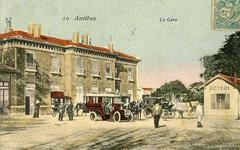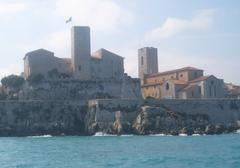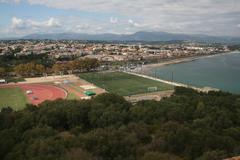
Absinthe Museum Antibes: Visiting Hours, Tickets, and Travel Guide
Date: 03/07/2025
Introduction
Tucked away in the atmospheric heart of Antibes’ Old Town, the Absinthe Museum (Musée de l’Absinthe) invites visitors on a sensory-rich journey through the history, rituals, and cultural impact of France’s most iconic spirit: absinthe, the legendary “green fairy.” Housed in a vaulted 9th-century cellar beneath ancient Roman foundations, the museum combines a bar, gallery, and educational space where vintage artifacts, interactive tastings, and artistic legacies converge. Whether you’re a history enthusiast, spirits aficionado, or curious traveler, this comprehensive guide details everything you need to plan your visit—from opening hours and ticket prices to travel tips, accessibility, and nearby attractions. (seeantibes.com; barefootblogger.com; antibes-juanlespins.com)
Table of Contents
- Absinthe: Origins and Rise in France
- Cultural Significance and Mythology
- Why Antibes? The Local Connection
- Absinthe Museum Antibes: Location and Visitor Info
- Museum Experience: Exhibits and Ritual
- Tastings, Souvenirs, and Thematic Events
- Nearby Attractions in Antibes
- FAQs
- Plan Your Visit: Tips and Recommendations
- Sources and Further Reading
Absinthe: Origins and Rise in France
Absinthe, an anise-flavored spirit distilled from wormwood, green anise, and fennel, originated in late 18th-century Switzerland. Its journey to fame began when French soldiers returning from North Africa brought their taste for absinthe home, spurring nationwide popularity from the 1840s. By the Belle Époque, absinthe had become a daily ritual: “l’heure verte” (the green hour) saw artists, writers, and everyday patrons gather in cafés, fueling both creativity and controversy (seeantibes.com).
Industrial production made absinthe affordable, and by 1910, France consumed over 36 million liters annually. However, concerns about its alleged hallucinogenic effects and social impact led to its prohibition in 1915. The myths and allure endured, and after nearly a century, absinthe saw a revival—now celebrated as a symbol of French heritage and artistic inspiration.
Cultural Significance and Mythology
Absinthe’s mystique is rooted in its association with bohemian Paris. The ritual of preparation—dripping ice water over a sugar cube atop a slotted spoon—became an art form, immortalized in paintings by Manet, Degas, and Toulouse-Lautrec, and in the writings of poets like Verlaine and Baudelaire. Absinthe was muse and scapegoat, blamed for madness yet praised for fueling genius.
Despite its ban, absinthe’s legend persisted in popular culture, influencing generations of artists and distillers. The museum explores these dualities, dispelling myths while celebrating its role as both a creative catalyst and historical curiosity (seeantibes.com).
Why Antibes? The Local Connection
While Paris was the epicenter of absinthe culture, Antibes—renowned for its vibrant artistic community and Mediterranean charm—offers a fitting tribute to the green fairy’s legacy. The Absinthe Museum is set within the Old Town, a district once frequented by Picasso and other luminaries, reinforcing the link between absinthe, art, and the bohemian Riviera lifestyle (barefootblogger.com).
Absinthe Museum Antibes: Location and Visitor Info
Address and Getting There
- Address: 25 Cours Masséna, 06600 Antibes, France
- By Train: Antibes station is a 15-minute walk via city center.
- By Bus: Bus 100 from Nice/Monaco or local lines stop near the Old Town.
- By Car: Parking is limited; public transport or walking is recommended.
Opening Hours
- Tuesday to Sunday: 10:00 AM – 6:00 PM
- Closed: Mondays and public holidays
- Note: Seasonal variations possible; check the official tourism website for updates.
Ticket Prices
- Adults: €8
- Reduced (students, seniors): €5
- Children under 12: Free
- Guided Tastings: Often an additional fee; advance booking recommended.
Accessibility
- Housed in a historic cellar with stairs and uneven floors; partial accessibility.
- Contact the museum ahead for assistance if you have mobility concerns.
Museum Experience: Exhibits and Ritual
Exhibits and Collections
- Vintage Bottles: Rare 19th and 20th-century absinthe bottles, reflecting branding and historical distilling trends (evendo.com).
- Paraphernalia: Antique spoons, glassware, carafes, and iconic absinthe fountains—each illustrating the artistry of the absinthe ritual (seeantibes.com).
- Posters and Artworks: Original advertising posters, period lithographs, and artworks inspired by absinthe’s influence on the arts (iconicriviera.com).
- Educational Panels: Detailed displays unravel the science, myths, and evolving legal status of absinthe.
The Absinthe Ritual
Every visit includes a demonstration of the traditional preparation: ice water is dripped over a sugar cube on a slotted spoon, creating the signature “louche” as the green liquid turns opalescent. Guests are encouraged to participate, making the experience both educational and theatrical (Wondrous Drifter).
Ambiance
The museum’s cellar setting—with stone walls, zinc bar, and green-glowing bottles—evokes the clandestine atmosphere of 19th-century absinthe cafés. Staff add a playful touch, donning period hats and inviting guests to do the same (CityXee).
Tastings, Souvenirs, and Thematic Events
Guided Tastings
- Sample a curated selection of absinthes (French, Swiss, and beyond), guided by knowledgeable staff.
- Learn to distinguish herbal aromas and flavor profiles.
- Advanced tastings or workshops may require prior booking (evendo.com).
Souvenirs
- Purchase absinthe bottles, glassware, spoons, and memorabilia.
- Gift shop also offers non-alcoholic items and informative books.
Events
- The museum occasionally hosts art exhibitions, lectures, and themed evenings—check the official website or inquire during your visit.
Nearby Attractions in Antibes
Enhance your cultural itinerary with these nearby highlights:
- Picasso Museum: Housed in Château Grimaldi, displaying works created during Picasso’s Antibes residency.
- Fort Carré: 16th-century fortress with panoramic sea views.
- Antibes Provençal Market: Famous for local produce and crafts.
- Port Vauban: Picturesque harbor and yachting hub.
Annual events like the Antibes Jazz Festival and art fairs further enrich your visit.
FAQs
Q: What are the Absinthe Museum’s opening hours?
A: Tuesday–Sunday, 10:00 AM–6:00 PM. Closed Mondays and public holidays. Confirm hours seasonally.
Q: How much are tickets?
A: €8 for adults, €5 for students/seniors, free for children under 12.
Q: Is the museum accessible?
A: Partial accessibility due to stairs and cellar layout. Contact in advance for assistance.
Q: Are tastings included?
A: Tastings may carry an additional fee; booking in advance is recommended.
Q: Can I take photos?
A: Photography is generally permitted without flash.
Q: Is there a dress code?
A: No formal code, but vintage hats/accessories are encouraged for fun.
Q: Can children visit?
A: The museum is primarily for adults due to alcohol service.
Plan Your Visit: Tips and Recommendations
- Arrive early in peak seasons to avoid crowds.
- Engage in the ritual—don’t miss the chance to prepare and taste absinthe as it was enjoyed a century ago.
- Pair your visit with Antibes’ many galleries, markets, and seaside walks for a full Riviera experience.
- Use public transport as parking in the Old Town is limited.
Digital Resources
- Download the Audiala app for self-guided tours, virtual exhibits, and local event updates.
- Enhance your trip with internal guides to Antibes historical sites.
Sources and Further Reading
- seeantibes.com
- barefootblogger.com
- antibes-juanlespins.com
- iconicriviera.com
- Wondrous Drifter
- evendo.com
- CityXee




